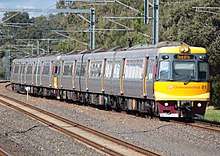Track gauge conversion
| Track gauge | ||||||||||||||||||||||||||||||||||||||||||||||||||||||||||||||||||||||||||||||||||||||||
|---|---|---|---|---|---|---|---|---|---|---|---|---|---|---|---|---|---|---|---|---|---|---|---|---|---|---|---|---|---|---|---|---|---|---|---|---|---|---|---|---|---|---|---|---|---|---|---|---|---|---|---|---|---|---|---|---|---|---|---|---|---|---|---|---|---|---|---|---|---|---|---|---|---|---|---|---|---|---|---|---|---|---|---|---|---|---|---|---|
| By transport mode | ||||||||||||||||||||||||||||||||||||||||||||||||||||||||||||||||||||||||||||||||||||||||
|
Tram · Rapid transit Miniature · Scale model |
||||||||||||||||||||||||||||||||||||||||||||||||||||||||||||||||||||||||||||||||||||||||
| By size (list) | ||||||||||||||||||||||||||||||||||||||||||||||||||||||||||||||||||||||||||||||||||||||||
|
||||||||||||||||||||||||||||||||||||||||||||||||||||||||||||||||||||||||||||||||||||||||
| Change of gauge | ||||||||||||||||||||||||||||||||||||||||||||||||||||||||||||||||||||||||||||||||||||||||
|
Break-of-gauge · Dual gauge · Conversion (list) · Bogie exchange · Variable gauge |
||||||||||||||||||||||||||||||||||||||||||||||||||||||||||||||||||||||||||||||||||||||||
| By location | ||||||||||||||||||||||||||||||||||||||||||||||||||||||||||||||||||||||||||||||||||||||||
|
North America · South America · Europe · Australia  |
||||||||||||||||||||||||||||||||||||||||||||||||||||||||||||||||||||||||||||||||||||||||
Gauge conversion is the change of one railway track gauge to another. This may be required if loads are too heavy for the existing track gauge or if rail cars are of a broader gauge than the existing track gauge. Gauge conversion may become less important as time passes due to the development of variable gauge systems, also called Automatic Track Gauge Changeover Systems.
Sleepers
If tracks are converted to a narrower gauge, the existing sleepers may be used. However, replacement is required if the conversion is to a wider gauge. Some sleepers may be long enough to accommodate the fittings of both existing and alternative gauges. Timber sleepers are suitable for conversion because they can be drilled for the repositioned rail spikes. Being difficult to drill, concrete sleepers are less suitable for conversion. Concrete sleepers may be cast with alternative gauge fittings in place. Steel sleepers may have alternative gauge fittings cast at production, may be drilled for new fittings or may be welded with new fittings.
For example, during the conversion of the Melbourne–Adelaide railway in Australia from 1,600 mm (5 ft 3 in) to 1,435 mm (4 ft 8 1⁄2 in) a sleeper with variable gauges and a reversible chair for the Pandrol clip was used.
Structures
Conversion from a narrow to a wider gauge may require enlargement of structures such as bridges, overpasses and tunnels, embankments and cuts. The minimum curve radius may have a wider radius on broader gauges requiring route deviations to allow the minimum curve radius to be increased. Track centers at stations with multiple tracks may also have to be moved. Conversion from narrow to standard gauge means several changes not because of the gauge itself, but in order to be compatible with the standards of standard gauge so trains can be exchanged, such as height of overpasses and choice of train couplers.
Rolling stock
Where vehicles move to a different gauge, they must be prepared with a change in the bogie (chassis) or be constructed with adjustable gauge axles. For example, passenger trains moving between the 1,435 mm (4 ft 8 1⁄2 in) gauge in France, and the 1,668 mm (5 ft 5 21⁄32 in) gauge in Spain, pass through an installation which adjusts their variable gauge axles. This process is known as "gauge change".
Steam locomotives
Few steam locomotives are constructed to allow for gauge change. Those that are include some in East African Railways, Garratts, and the Victorian Railways R class R766. Construction of steam locomotives in this way is difficult due to the position of the boilers and the fireboxes. The gauge change is only to a wider gauge.
In about 1860, the Bristol and Exeter Railway converted five 1,435 mm (4 ft 8 1⁄2 in) gauge locomotives to 7 ft (2,134 mm) gauge, and later converted them back again. Also in the 19th century, in the United States, some broad 1,524 mm (5 ft) gauge locomotives were designed for easy conversion to 1,435 mm (4 ft 8 1⁄2 in) gauge. In the 20th century, in Victoria station, London, some broad 1,600 mm (5 ft 3 in) gauge locomotive classes were designed for easy conversion to a narrower 1,435 mm (4 ft 8 1⁄2 in) gauge. Between 1922 and 1949, five South Australian Railways T class narrow 1,067 mm (3 ft 6 in) gauge locomotives were converted to Tx-class broad 1,600 mm (5 ft 3 in) gauge, and later back again. After World War II, a number of captured German 03 class Pacifics locomotives were regauged to the Russian gauge.
Diesel and electric trains
Most diesel and electric rolling stock can undergo gauge conversion by replacement of their bogies. Engines with fixed wheelbases are more difficult to convert. In Australia, diesel locomotives are regularly re-gauged between broad, standard, and narrow gauges.
Wagons and coaches
Gauge conversion of wagons and coaches involves the replacement of the wheelset or the bogies. In May 1892, wagons and coaches were converted when the 7 ft 1⁄4 in (2,140 mm) gauge of the Great Western Railway was abandoned.
Gauge orphan
During gauge conversion work, some stations and branch lines may become "gauge orphans". Trains can't operate to them until costly gauge conversion work is completed. For example, between Seymour and Albury in Australia, some branch lines (such as Benalla to Oaklands) and some stations, such as Violet Town have become gauge orphans.
See also
| Wikimedia Commons has media related to Manual gauge changing. |
| Wikimedia Commons has media related to Automated gauge changing. |

